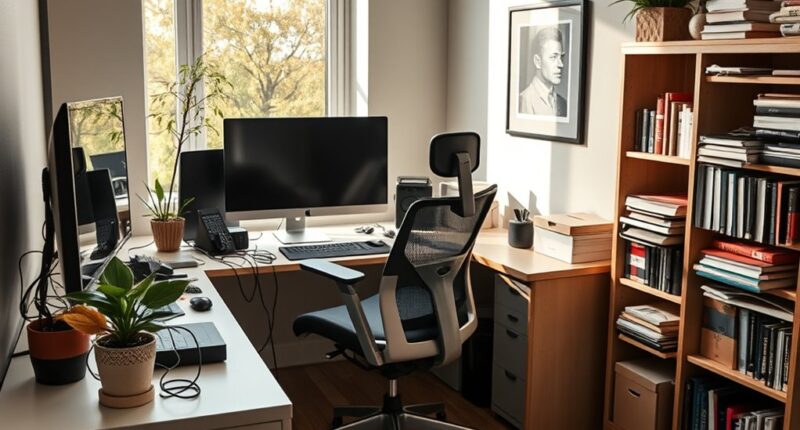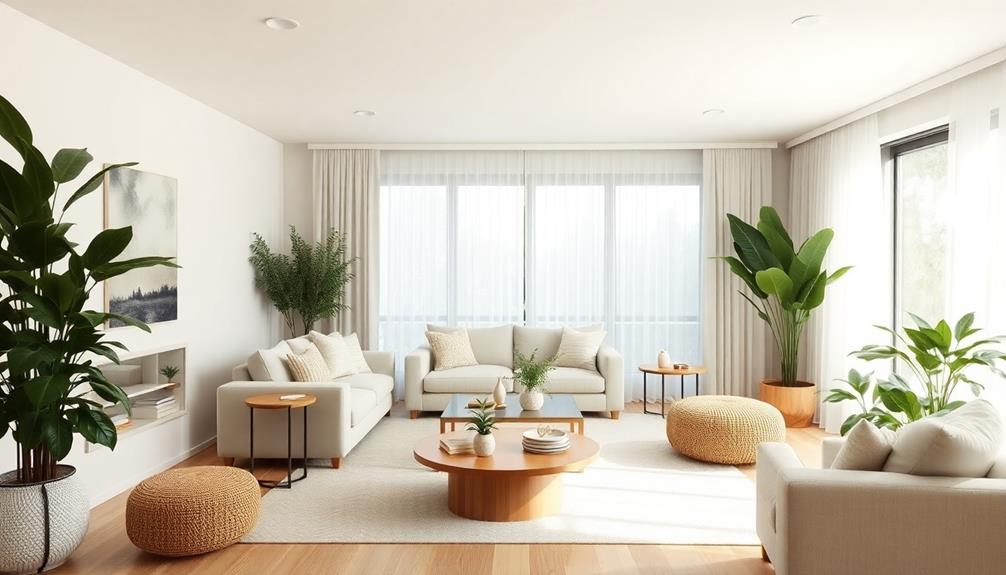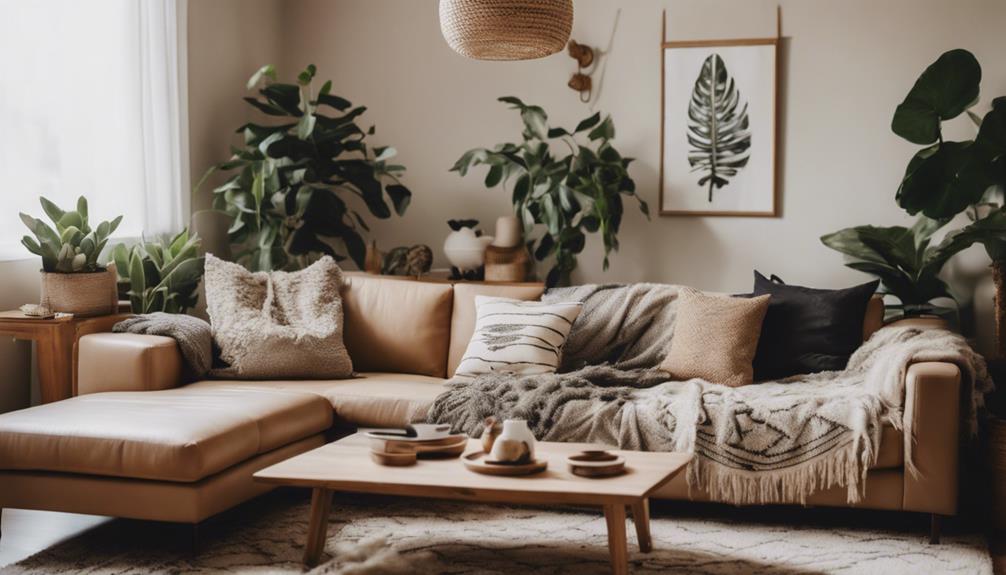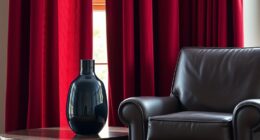Many people make simple mistakes when setting up their home office, like choosing the wrong desk or chair that causes discomfort, neglecting proper lighting that strains your eyes, or overloading your space with clutter that hampers productivity. Ignoring ergonomics, poor cable management, and insufficient storage also create chaos and frustration. Plus, a lack of personalization can make your workspace feel uninspiring. Keep these common pitfalls in mind to optimize your setup and discover tips to improve comfort and efficiency.
Key Takeaways
- Ignoring ergonomic principles leads to discomfort and long-term health issues; ensure proper desk and chair setup.
- Poor lighting, either too dim or harsh, strains eyes and hampers productivity; maximize natural light and use glare-free artificial lighting.
- Cluttered and disorganized spaces reduce efficiency; regularly declutter and utilize vertical storage solutions.
- Keeping unnecessary office supplies and equipment creates chaos; only retain essential items for a tidy workspace.
- Neglecting workspace personalization and comfort decreases motivation; add personal touches and maintain a clean, inviting environment.
Choosing the Wrong Desk and Chair
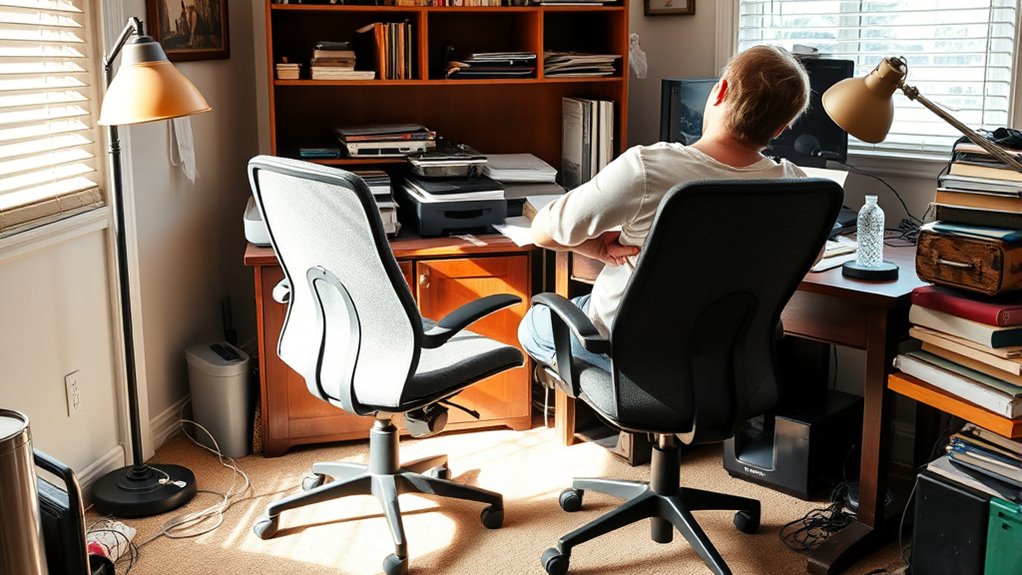
Choosing the wrong desk and chair can quickly turn your home office into an uncomfortable and inefficient space. If your desk is too high or too low, it forces you into awkward postures, leading to discomfort and long-term health issues. Make sure your desk height considerations allow your elbows to rest at a 90-degree angle when typing, reducing strain. An ergonomic adjustment for your chair is just as important—your chair should support your lower back and keep your feet flat on the floor. Avoid furniture that doesn’t promote good posture. Proper ergonomic adjustments ensure you stay comfortable and focused, preventing fatigue and aches. Taking the time to select the right desk height and an adjustable chair helps create a more productive, healthier workspace. Additionally, understanding ergonomic principles can help you make better furniture choices to support your wellbeing.
Neglecting Proper Lighting

If your home office doesn’t have enough natural light or uses poor artificial lighting, it can strain your eyes and reduce productivity. You might not notice how much these issues affect your focus until you experience fatigue or headaches. Addressing both natural and artificial light properly can make a significant difference in your work environment. Ensuring proper sleep hygiene practices in your workspace can also help prevent eye strain and improve overall alertness during work hours.
Insufficient Natural Light
Have you ever noticed how working in a space with little natural light can drain your energy and make it harder to focus? Insufficient sunlight can lead to fatigue and reduce productivity. To fix this, consider your window treatments—opt for sheer curtains or blinds that let in more light without glare. Proper plant placement also helps; placing plants near windows not only brightens your space but boosts your mood. Avoid heavy drapes that block sunlight, and position your desk near windows to maximize daylight exposure. Making these adjustments ensures your workspace feels more open and inviting, keeping you energized throughout the day. Remember, natural light isn’t just about visibility—it directly impacts your well-being and work performance. Incorporating Gold IRA Rollovers into your long-term retirement strategy can also help secure your financial future while you focus on creating an optimal home office environment.
Poor Artificial Illumination
While natural light plays an essential role in maintaining energy and focus, many home office setups overlook the importance of proper artificial lighting. Poor artificial illumination can cause eye strain, headaches, and fatigue, reducing productivity. To avoid this, you need effective task lighting that illuminates your workspace without glare or shadows. Choosing the right color temperature is equally important; a cooler, daylight-like tone (around 5000K-6500K) helps keep you alert and focused. Avoid harsh, overly warm, or dim lighting, which can make your workspace feel gloomy or strain your eyes. Proper artificial lighting ensures your workspace is bright, comfortable, and conducive to concentration, especially during evenings or cloudy days. Investing in quality task lighting with the correct color temperature can notably improve your overall home office experience. Additionally, using appropriate bulbs that emit consistent light can prevent flickering and further reduce eye fatigue.
Overloading the Space With Clutter
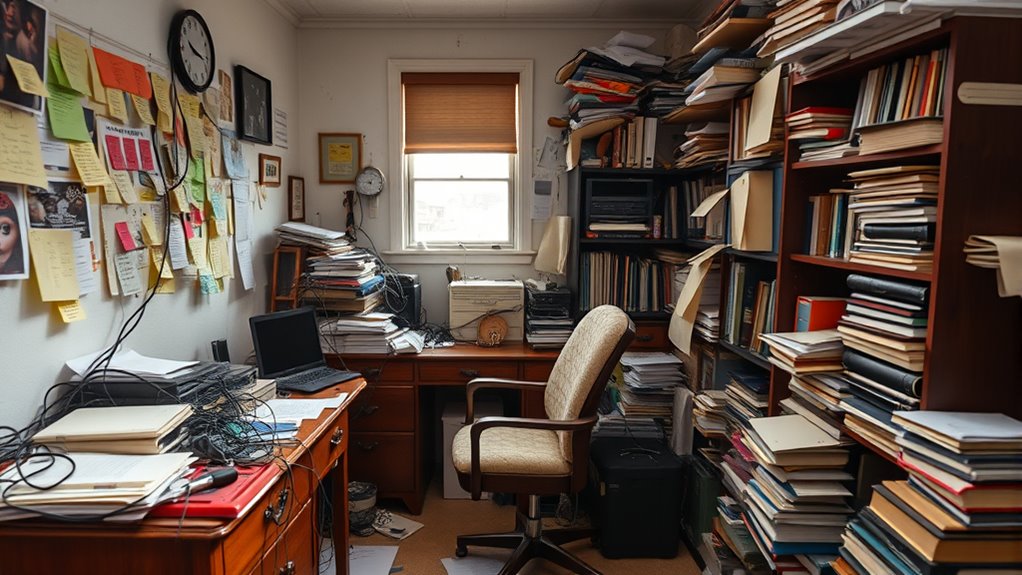
When your home office becomes filled with excess decor, unnecessary supplies, or poorly placed storage, it can quickly become overwhelming. Clutter not only hampers your productivity but also makes the space feel cramped and chaotic. To keep your workspace efficient, it’s important to regularly evaluate and remove items that aren’t essential. Incorporating effective organizational tools, such as storage solutions or designated zones, can greatly improve the functionality of your setup.
Excess Decor Accumulation
Is your home office feeling cramped because of too many decorative items? Overloading your space with decorative accessories can hinder your home office aesthetics and make the area feel cluttered. While a few carefully chosen pieces add personality, too many create visual chaos and distract from your work. Instead, opt for a minimalist approach—select a few meaningful decorations that enhance your environment without overwhelming it. Keep surfaces clear and store extra accessories out of sight. This not only clears physical space but also reduces mental clutter, helping you stay focused. Remember, a clean, organized workspace promotes productivity and calm. Striking the right balance between decor and functionality ensures your home office remains inviting without sacrificing efficiency. Incorporating vertical storage solutions can further optimize your space by utilizing height rather than surface area.
Unnecessary Office Supplies
Do you find your desk buried under stacks of unused pens, sticky notes, and random paperwork? Unnecessary office supplies often lead to clutter and reduce productivity. You might be tempted by stationery overspending or decorative excess, but these extras only create chaos. To keep your workspace streamlined, consider:
- Excess pens and highlighters that rarely get used
- Outdated or duplicate notebooks and notepads
- Decorative paper clips and novelty stationery
- Items purchased on impulse during sales
Eliminating these unnecessary supplies helps you focus on essentials, saves space, and limits distractions. Remember, a cluttered desk hampers efficiency and can make your home office feel overwhelming. Keeping only what you need prevents overspending and maintains a professional, organized environment. Additionally, color accuracy in your workspace lighting can influence your mood and productivity levels.
Ill-Placed Storage Solutions
Have you ever noticed how overloading your desk with storage solutions can turn your workspace into a cluttered chaos? Piling on random storage options without planning can make it harder to find what you need and hinder your productivity. Instead, opt for custom storage options that fit your space and workflow. Use decorative storage ideas like stylish bins, wall-mounted shelves, or sleek drawers to keep essentials organized yet accessible. Proper placement is key—avoid placing everything in one spot or stacking items haphazardly. When storage solutions are well thought out and strategically positioned, they free up workspace and create a clean, professional environment. Remember, clutter doesn’t just look bad; it can also distract you from your tasks. Paying attention to workspace organization can significantly enhance your efficiency and reduce stress.
Ignoring Ergonomics
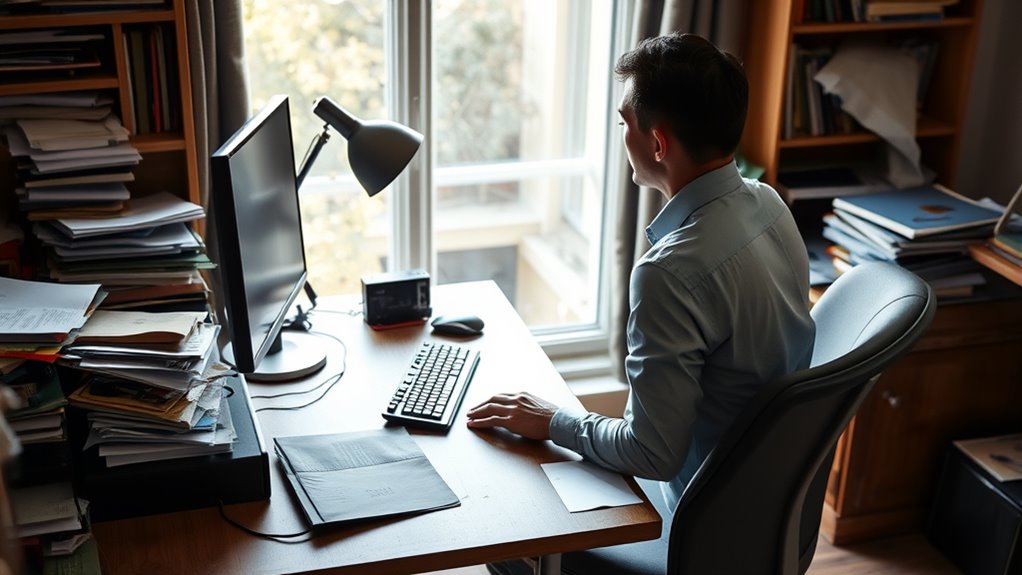
Neglecting ergonomics in your home office can lead to discomfort and long-term health issues. Without proper setup, you might experience neck strain, back pain, or repetitive stress injuries. To prevent this, prioritize ergonomic accessories such as adjustable chairs, keyboard stands, and monitor risers. Cultivating posture awareness helps you maintain a neutral spine and reduce fatigue. Consider these key points:
Prioritize ergonomic setup to prevent discomfort and promote long-term health in your home office.
- Choose an adjustable chair that supports your lower back.
- Position your monitor at eye level to avoid neck strain.
- Use ergonomic accessories to promote natural wrist and arm positions.
- Take regular breaks to stretch and reset your posture.
Addressing ergonomics ensures a healthier, more comfortable workspace, boosting productivity and preventing future health problems.
Poor Placement of Technology and Cables
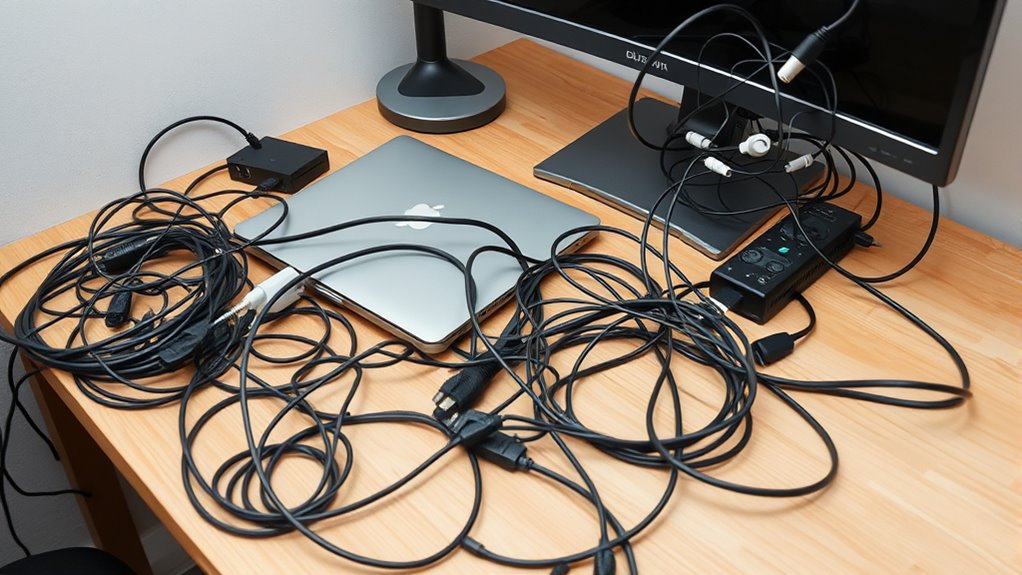
Poor placement of technology and cables can quickly turn an ergonomic setup into a cluttered, unsafe workspace. Without proper cable management, cords can tangle, cause tripping hazards, and make your desk look chaotic. To avoid this, focus on device positioning so screens, keyboards, and mice are within easy reach and aligned for comfort. Use cable clips, sleeves, or under-desk trays to keep cords organized and hidden. Proper cable management not only improves safety but also enhances efficiency, allowing you to work without constantly adjusting or searching for the right connections. Regularly check your cables to prevent wear and tear. Implementing effective cable management techniques can significantly improve your workspace organization and safety. A tidy, well-organized setup minimizes distractions and creates a more professional, productive environment.
Insufficient Storage Solutions
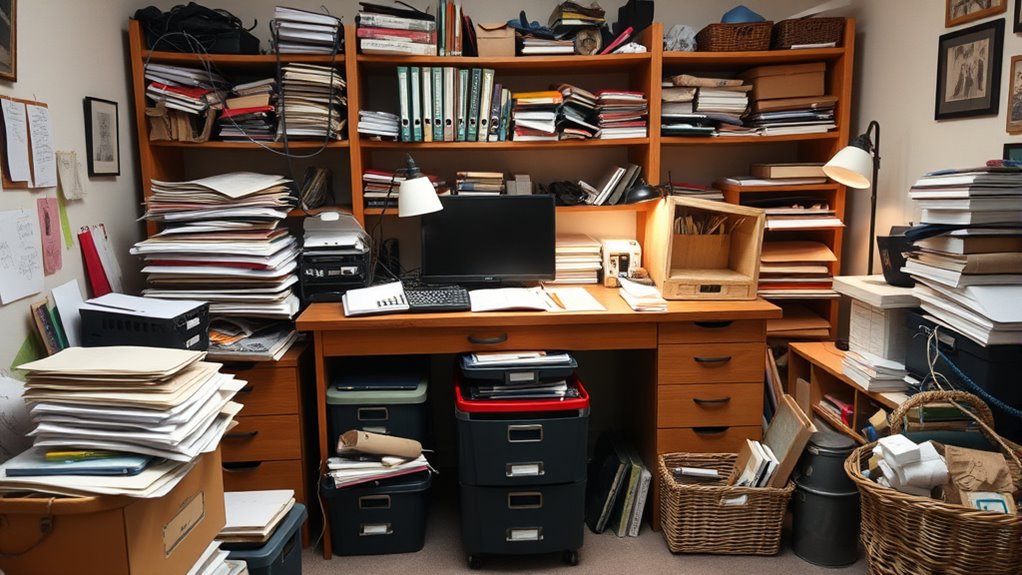
Are you struggling to keep your home office organized because of limited storage? Insufficient storage solutions can quickly turn your workspace into chaos. To maximize space, consider using storage bins to categorize supplies and keep clutter out of sight. Incorporate shelving units to elevate essential items and free up desk space. Proper organization helps you find what you need faster and maintains a professional look. Additionally, smart design principles can guide you in creating efficient storage setups tailored to your space and needs.
Lack of Personalization and Comfort
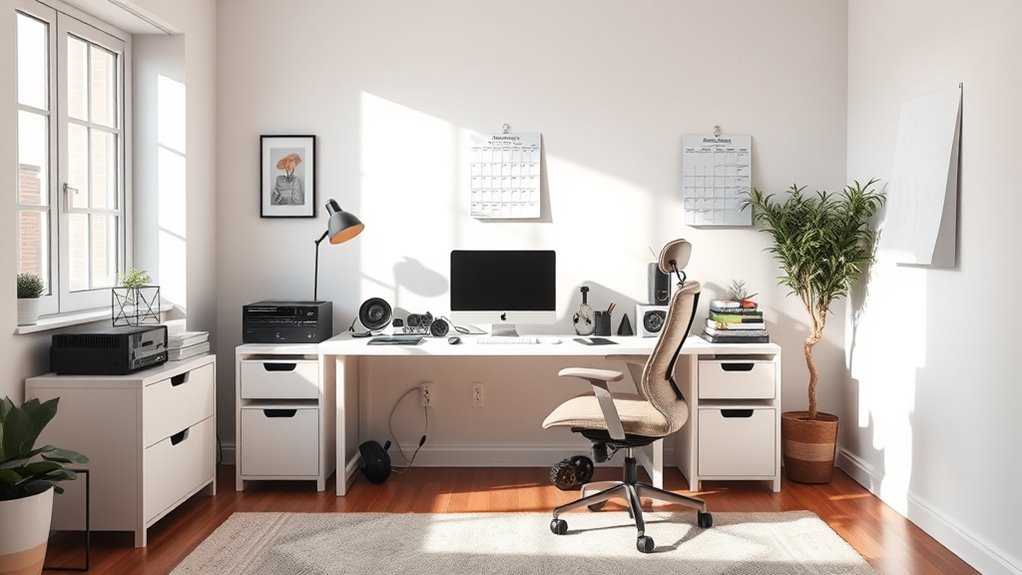
A home office that lacks personalization and comfort can quickly feel impersonal and uninspiring, making it harder to stay motivated throughout the workday. Without decorative accessories or personalized artwork, your space may seem sterile and dull, reducing your enthusiasm for work. Adding small touches like favorite photos, inspiring quotes, or unique accessories can make a big difference. Incorporate elements that reflect your personality and comfort preferences to create a space where you enjoy spending time. Comfortable seating, cozy lighting, and meaningful decor help you feel more relaxed and focused. When your home office feels personal and inviting, you’ll naturally work more efficiently and stay motivated longer. Personal touches turn a generic workspace into a true extension of your personality and style.
Frequently Asked Questions
How Can I Improve Acoustics in My Home Office?
To enhance acoustics in your home office, start by using soundproofing techniques like adding rugs, curtains, and weatherstripping to reduce noise. Place acoustic panels strategically on walls, focusing on areas where sound bounces or echoes. Guarantee proper acoustic panel placement to absorb sound effectively without cluttering your space. Regularly adjust these elements for ideal sound quality, creating a quieter, more focused work environment that boosts productivity.
What Are the Best Plants to Enhance Productivity?
Want a secret productivity boost? Get air purifying plants like snake plants or pothos—they’re low maintenance greenery that cleans your air while making your workspace look less like a cave. These plants thrive on neglect, so you won’t spend hours watering them. Plus, their calming presence can help reduce stress and keep you focused. So, add some leafy friends and watch your workday turn into a lush, productive paradise.
How Do I Create a Dedicated Workspace in a Small Apartment?
You can create a dedicated workspace in your small apartment by choosing a corner and using color coordination to define it. Add a desk that fits your space and optimize lighting with adjustable lamps or natural light. Keep clutter minimal and use storage solutions to maintain organization. This way, you establish a clear, functional area that boosts productivity without sacrificing your apartment’s coziness.
What Are Budget-Friendly Options for Ergonomic Accessories?
You can find budget-friendly ergonomic accessories that offer cost-effective comfort solutions without breaking the bank. Look for adjustable lumbar support cushions, affordable ergonomic keyboards, and versatile footrests made from budget materials. Thrift stores and online marketplaces often have gently used options. Simple DIY solutions, like homemade wrist rests or cushion supports, can also improve your comfort. These small investments help you create a healthier, more comfortable workspace on a budget.
How Often Should I Upgrade My Office Technology?
You should upgrade your office technology every 3 to 5 years, aligning with the typical hardware refresh cycle. This guarantees your devices stay efficient and secure, avoiding slowdowns or vulnerabilities. Pay attention to performance issues or compatibility problems, which might signal it’s time for an upgrade sooner. Regularly evaluating your tech’s performance helps you determine the best tech upgrade frequency, keeping your home office running smoothly and securely.
Conclusion
Don’t let these common mistakes hold you back from a productive, comfortable workspace. You might think fixing everything is overwhelming or expensive, but small changes can make a huge difference. Prioritize ergonomics, lighting, and organization, and you’ll notice improved focus and comfort. Remember, creating a perfect home office isn’t about perfection but progress. Start with one or two adjustments today—you’ll be surprised how much it boosts your work-from-home experience.
